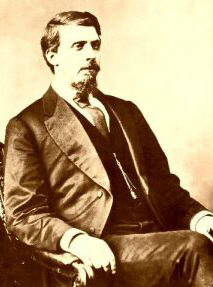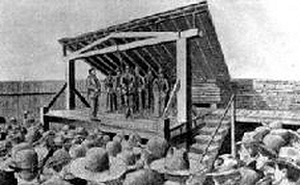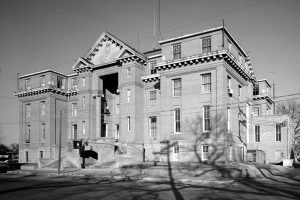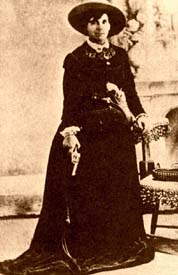indian territory
 The Indian Territory, which is now Oklahoma, in 1875, was populated by cattle and horse thieves, whiskey peddlers, and bandits who sought refuge in the untamed territory that was free of a “White Man’s Court.” There was one court with jurisdiction over Indian Territory was the U.S. Court for the Western District of Arkansas located in Fort Smith, Arkansas, which was situated on the border of Western Arkansas and Indian Territory. Judge Isaac Parker, who was often called the “Hanging Judge,” from Fort Smith, Arkansas ruled over the lawless land of Indian Territory in the late 1800s. He was determined to stop the pollution of the Indian Territory that was the outlaws who thought they could outrun the law.
The Indian Territory, which is now Oklahoma, in 1875, was populated by cattle and horse thieves, whiskey peddlers, and bandits who sought refuge in the untamed territory that was free of a “White Man’s Court.” There was one court with jurisdiction over Indian Territory was the U.S. Court for the Western District of Arkansas located in Fort Smith, Arkansas, which was situated on the border of Western Arkansas and Indian Territory. Judge Isaac Parker, who was often called the “Hanging Judge,” from Fort Smith, Arkansas ruled over the lawless land of Indian Territory in the late 1800s. He was determined to stop the pollution of the Indian Territory that was the outlaws who thought they could outrun the law.
Judge Isaac Parker was born in a log cabin outside Barnesville, Belmont County, Ohio on October 15, 1838. The youngest son of Joseph and Jane Parker. As a boy, Isaac helped out on the farm, but never really cared for that type of work. He attended the Breeze hill primary school and then the Barnesville Classical Institute. Knowing he wanted more, he decided to go for a higher education. To help pay for it, he taught students in a country primary school. When he was 17 he decided to study law, his legal training consisting of a combination of apprenticeship and self study. Reading law with a Barnesville attorney, he passed the Ohio bar exam in 1859 at the age of 21. During this period of his life, he met and married Mary O’Toole and the couple had two sons, Charles and James. Over the years, Parker built a reputation for being an honest lawyer and a much respected leader of the community.
After Parker passed the bar, he decided to head west, ending up in Saint Joseph, Missouri a bustling Missouri River port town. He went to work for his uncle, D.E. Shannon, becoming a partner in the Shannon and Branch legal firm. By 1861, he was working on his own in both the municipal and county criminal courts. In April of 1861, he won the election as City Attorney. He was re-elected to the post for the next two years. In 1864,  Isaac Parker ran for county prosecutor of the Ninth Missouri Judicial District and in the fall of that same year, he served as a member of the Electoral College, casting his vote for Abraham Lincoln. During a political career that included a six-year term as judge of the Twelfth Missouri Circuit in 1868, Parker would soon gain the experience that he would later use as the ruling Judge over the Indian Territory.
Isaac Parker ran for county prosecutor of the Ninth Missouri Judicial District and in the fall of that same year, he served as a member of the Electoral College, casting his vote for Abraham Lincoln. During a political career that included a six-year term as judge of the Twelfth Missouri Circuit in 1868, Parker would soon gain the experience that he would later use as the ruling Judge over the Indian Territory.
After the Civil War, the number of outlaws had grown, wrecking the relative peace of the five civilized tribes that lived in Indian Territory. By the time Parker arrived at Fort Smith, the Indian Territory had become known as a very bad place, where outlaws thought the laws did not apply to them and terror reigned. Parker replaced Judge William Story, whose tenure had been marred by corruption, after arriving in Fort Smith on May 4, 1875. At the age of 36, Judge Parker was the youngest Federal judge in the West. Holding court for the first time on May 10, 1875, eight men were found guilty of murder and sentenced to death. Judge Parker held court six days a week, often up to ten hours each day and tried 91 defendants in his first eight weeks on the bench. He was determined to clean up the Indian Territory, single handedly if necessary. In that first summer, eighteen persons came before him charged with murder and 15 were convicted. Eight of them were sentenced to die on the gallows on September 3, 1875. However, only six would be executed as one was killed trying to escape and a second had his sentence commuted to life in prison because of his young age.
The day of the September 3, 1875 hanging was a media circus, and because of all the attention, everyone knew that the once corrupt court was functioning properly again. Parker’s critics dubbed him the “Hanging Judge” and called his court the “Court of the Damned.” They thought Judge Parker was too harsh. The Fort  Smith Independent was the first newspaper to report the event on September 3, 1875 with the large column heading reading: “Execution Day!!” Other newspapers around the country reported the event a day later. These press reports shocked people throughout the nation. “Cool Destruction of Six Human Lives by Legal Process” screamed the headlines. Of the six felons, three were white, two were Native American and one was black. When the preliminaries were over, the six were lined up on the scaffold while executioner George Maledon adjusted the nooses around their necks. The trap was sprung all six died at once at the end of the ropes. The event solidified Judge Parker’s nickname for all time. In 21 years on the bench, Judge Parker tried 13,490 cases, 344 of which were capital crimes. 9,454 cases resulted in guilty pleas or convictions. Over the years, Judge Parker sentenced 160 men to death by hanging, though only 79 of them were actually hanged. The rest died in jail, appealed or were pardoned. Judge Parker died on November 17, 1896.
Smith Independent was the first newspaper to report the event on September 3, 1875 with the large column heading reading: “Execution Day!!” Other newspapers around the country reported the event a day later. These press reports shocked people throughout the nation. “Cool Destruction of Six Human Lives by Legal Process” screamed the headlines. Of the six felons, three were white, two were Native American and one was black. When the preliminaries were over, the six were lined up on the scaffold while executioner George Maledon adjusted the nooses around their necks. The trap was sprung all six died at once at the end of the ropes. The event solidified Judge Parker’s nickname for all time. In 21 years on the bench, Judge Parker tried 13,490 cases, 344 of which were capital crimes. 9,454 cases resulted in guilty pleas or convictions. Over the years, Judge Parker sentenced 160 men to death by hanging, though only 79 of them were actually hanged. The rest died in jail, appealed or were pardoned. Judge Parker died on November 17, 1896.
 The Old West was a wild, untamed place, and the people who lived there had to be tough as nails too. During that time, the Indian Territory, now Oklahoma, was considered the most violent of the American territories. Along with the Indians, it served as home to hundreds of outlaws from around the country. These were hardened criminal men, accused of murder, rape, robbery, arson, adultery, bribery, and numerous other crimes. They headed to the Indian Territory, looking for a place to hideout…a place where the lawmen couldn’t follow. The Indian Territory was without law enforcement with the exception of the Indian Nations’ police forces, who had no jurisdiction over the many criminals who had taken flight from other states. It left the outlaws in a place of sweet freedom, from both types of law.
The Old West was a wild, untamed place, and the people who lived there had to be tough as nails too. During that time, the Indian Territory, now Oklahoma, was considered the most violent of the American territories. Along with the Indians, it served as home to hundreds of outlaws from around the country. These were hardened criminal men, accused of murder, rape, robbery, arson, adultery, bribery, and numerous other crimes. They headed to the Indian Territory, looking for a place to hideout…a place where the lawmen couldn’t follow. The Indian Territory was without law enforcement with the exception of the Indian Nations’ police forces, who had no jurisdiction over the many criminals who had taken flight from other states. It left the outlaws in a place of sweet freedom, from both types of law.
Then Judge Isaac Parker was appointed to the Western Judicial District of Arkansas, which included Indian Territory. All that sweet freedom was about to end. Parker decided to bring law and order to the Indian Territory…or at least to the criminal element of it. He commanded about 200 deputy marshals to “clean up” the lawless territory. It was a noble idea that would take years to accomplish, as the deputies struggled to cover some 74,000 square miles in their search for hundreds of wanted fugitives. The occupation of a U.S. Deputy Marshal courted constant danger, so much so that between 1872 and 1896, over 100 deputies died enforcing the law throughout the territory. A number of men made names for themselves working as U.S. Marshals in the Indian Territory. Men such as Heck Thomas, Bass Reeves, Bill Tilghman, Chris Madsen, and dozens of others.
There were also a number of other U.S. Marshals who, more quietly made names for themselves, mainly because they were women. I think that as a woman, I would not be so inclined to head into Indian Territory in those days to “clean up” the place. Women have long been considered a part of the “clean up” crew, but most of the time, it was as homemakers. I don’t think anyone thought they could be successful law enforcement officers…at least not in those days.
One of these brave women was F.M. Miller, who was appointed as a U.S. Deputy Marshal out of the federal court at Paris, Texas in 1891. When she was commissioned, she was the only female deputy working in Indian Territory. She was known to have accompanied Campbell on all his trips. During her tenure, she was mentioned in several newspaper articles including the Fort Smith Elevator on November 6, 1891 that described here as: “a dashing brunette of charming manners.” The article continued by stating: “The woman carries a pistol buckled around her and has a Winchester strapped to her saddle. She is an expert shot and a superb horsewoman, and brave to the verge of recklessness. It is said that she aspires to win a name equal to that of Belle Starr, differing from her by exerting herself to run down criminals and in the enforcement of the law.”
Another article appeared a couple of weeks later in the Muskogee Phoenix on November 19, 1891, which said that she had the reputation of being a fearless and efficient officer and had locked up more than a few offenders. The article continued: “Miss Miller is a young woman of prepossessing appearance, wears a cowboy hat and is always adorned with a pistol belt full of cartridges and a dangerous looking Colt pistol which she knows how to use. She has been in Muskogee for a few days, having come here with Deputy Marshal Cantrel, a guard with some prisoners brought from Talahina. Regarding Miss. Miller’s unique position as Deputy U.S. Marshal, another newspaper commented, “Hopefully in the future, there will be more information on this colorful peace officer.”
Another female U.S Marshal in Indian Territory who showed bravery and skill in her job was a young woman named Ada Curnutt. The daughter of a Methodist minister, Ada Curnutt moved to the Oklahoma Territory with her sister and brother-in-law shortly after it opened for settlers. The 20 year old soon found work as the Clerk of the District Court in Norman, Oklahoma and as a Deputy Marshal to U.S. Marshal William Grimes. Her most famous arrest occurred in March, 1893 when she received a telegram from Grimes, instructing her to send a deputy to Oklahoma City to bring in two notorious outlaws named Reagan and Dolezal who were wanted for forgery. I seriously doubt that Grimes meant for her to go, but all the other deputies were out in the field so Curnutt stepped up to the responsibility. She quickly boarded a train for Oklahoma City. When she arrived she discovered that the two men were in a saloon and quickly made her way there. Upon her arrival she asked a man on the street to go in and tell them that a lady needed to see them outside. The outlaws eagerly went out to meet her. When the two emerged, Ada read the warrants to them and stated that they were under arrest. Heavily armed, the two men laughed at the young woman and thinking it was a joke. They stupidly allowed her to place handcuffs over their wrists. When the captives began to realize that the joke was on them, Curnutt announced to the crowd gathered around them that she was prepared to deputize every man to aide her, if needed. As it turns out, it was not necessary, as she escorted them to the the train station and telegraphed the marshal’s office in Guthrie that she was bringing them in. She was 24 years old at the time. The two forgers  were soon tried and convicted. “Like all deputies of her era, she had to be extremely tough and ready to face a wide range of situations,” the U.S. Marshals Service wrote of Carnutt.
were soon tried and convicted. “Like all deputies of her era, she had to be extremely tough and ready to face a wide range of situations,” the U.S. Marshals Service wrote of Carnutt.
While it was unusual, there were a number of women in law enforcement, even before it was widely accepted as normal. All these women forged the way for the many women we have in law enforcement, and even in the military today. these women may have been the “clean up” crew, but they were a tough as nail clean up crew, and they made, and continue to make, history in the field of law enforcement, and in the military.
 Myra Belle Shirley was born in a log cabin near Carthage, Missouri on February 5, 1848 to “Judge” John Shirley, and his third wife, Elizabeth “Eliza” Pennington. John Shirley was the black sheep of a well-to-do Virginia family who had moved west to Indiana, where he married and divorced twice. His third wife, Eliza, was on the Hatfield side of the feuding Hatfield and McCoy families, which ranks up there with people I wouldn’t want for parents. The Hatfield and McCoy feuds, while not starting until about 1865, went on for decades, and they were messy and confusing over those years. You might no know who Myra Belle Shirley was, or you might know her best at Belle Starr.
Myra Belle Shirley was born in a log cabin near Carthage, Missouri on February 5, 1848 to “Judge” John Shirley, and his third wife, Elizabeth “Eliza” Pennington. John Shirley was the black sheep of a well-to-do Virginia family who had moved west to Indiana, where he married and divorced twice. His third wife, Eliza, was on the Hatfield side of the feuding Hatfield and McCoy families, which ranks up there with people I wouldn’t want for parents. The Hatfield and McCoy feuds, while not starting until about 1865, went on for decades, and they were messy and confusing over those years. You might no know who Myra Belle Shirley was, or you might know her best at Belle Starr.
Myra grew up in a well to do family, after her father John Shirley made good in 1856 when he and his wife sold their financially successful farming venture raising wheat, corn, hogs, and horses in Jasper County, Missouri. When John sold the land, they opened an inn, a tavern, livery stable and blacksmith shop. Their businesses took up almost an entire city block. John Shirley had become a respected member of the burgeoning county seat of Carthage, and his daughter Myra Belle lived the life of a spoiled, rich girl, attending the Carthage Female Academy, where in addition to the basics, she was taught music and classical languages. She was a bright student, with polite manners, and a talent for playing the piano. However, she also liked to flaunt her status a “rich girl” and liked having an audience. She also loved the outdoors, where she spent many a day roaming the countryside with her older brother Bud, who taught her how to ride a horse and handle a gun…a little out of the ordinary, but still within the confines of a proper upbringing, but dramatic changes were coming for Myra.
When the Kansas-Missouri Border War broke out. Jasper County watched both armies pass through time and again, forcing residents to take sides, and making neighbors into bitter enemies. Irregular bands of “Jayhawkers” and “Red Legs” laid waste to Missouri communities in support of the Union. When son Bud joined Quantrill’s Raiders, John Shirley was a proud father. Bud, who knew the area and the people well, served admirably as a scout, quickly attaining a captain’s rank. But in June 1864 Bud was killed in Sarcoxie, Missouri. The raids had taken their toll on Shirley’s businesses and after Bud’s death, the “Judge” gave up, sold his Missouri property and moved his family to a farm near Scyene, Texas, a small settlement southeast of Dallas.
In 1866 the James-Younger Gang robbed their first bank in Liberty, Missouri, and fled with $6,000 in cash and bonds. Splitting up, Jesse and Frank James, along with the Youngers, fled to Texas, where they met up with Myra Shirley. Soon, Myra became smitten by Cole, quickly becoming a member of their “gang.” One of these outlaw bands, seeking refuge, stayed at the Shirley house one night. Belle later stated that it was there that she became reacquainted with the first man she ever loved. His name was Jim Reed, and she had first met him back in Missouri, where the Reed and Shirley families had been friends. The romance blossomed in Texas, and Belle and Jim married on November 1, 1866. The Shirleys had no objection to the marriage, as Jim Reed was not yet a wanted man. Jim moved into the Shirley household near Scyene and shared the farm chores. Later, he became a salesman for a Dallas saddle and bridle maker. By late 1867, though, he and Belle were living on the Reed homestead in Missouri. Early in September 1868, Belle gave birth to her first child, Rosie Lee. Belle adored the baby and referred to her as her “Pearl.” The nickname stuck. When Jim and Belle moved to Missouri, Reed was a wanted man, allegedly for murdering a man named Shannon. The two fled to California with their young daughter Pearl and before long a second child came along who they named Edward.
In 1869 Belle, Reed and two other outlaws rode to the North Canadian river country, where they tortured an old Creek Indian until he told them where he had hidden $30,000 in gold. With their share of the loot, Jim and Belle returned to Texas, where she played the role of “Bandit Queen” to the hilt. But, it wasn’t long before the outlaw life caught up with Reed and on August 1874, Reed was killed in a gunfight by a member of his own gang. Belle left her children with her mother while she rode the outlaw trail. In Indian Territory (what is now Oklahoma,) Starr got involved with a flat-faced Indian outlaw who went by the name of “Blue Duck.” Of her life, Belle Starr stated to The Fort Smith Elevator about one year prior to her death, “I regard myself as a woman who has seen much of life.” On February 3, 1889, two days before her 41st birthday, she was killed. She was riding home from a neighbor’s house in Eufaula, Oklahoma, when she was ambushed. After she fell off her horse, she was shot again to make sure she was dead. Her death resulted from shotgun wounds to the  back and neck and in the shoulder and face. Legend says she was shot with her own double barrel shotgun. According to Frank “Pistol Pete” Eaton, her death was due to different circumstances. She had been attending a dance. Frank Eaton had been the last person to dance with Belle Starr when Edgar Watson, clearly intoxicated had asked to dance with her. When Belle Starr declined, he later followed her. When on the way home, she stopped to give her horse a drink at a creek, he shot and killed her. According to Frank Eaton, Watson was tried, convicted and executed by hanging for the murder.
back and neck and in the shoulder and face. Legend says she was shot with her own double barrel shotgun. According to Frank “Pistol Pete” Eaton, her death was due to different circumstances. She had been attending a dance. Frank Eaton had been the last person to dance with Belle Starr when Edgar Watson, clearly intoxicated had asked to dance with her. When Belle Starr declined, he later followed her. When on the way home, she stopped to give her horse a drink at a creek, he shot and killed her. According to Frank Eaton, Watson was tried, convicted and executed by hanging for the murder.
Belle’s children didn’t do much better, and turned out as one would expect, with the influence their mother had on them. Belle’s son, Eddie Reed, was convicted of horse theft and receiving stolen property in July 1889. Judge Parker sent him to prison in Columbus, Ohio. Belle’s daughter, Rosie Reed, also known as Pearl Starr, became a prostitute to raise funds for Eddie’s release. She did eventually obtain a presidential pardon in 1893. Ironically, Eddie became a deputy in Fort Smith and killed two outlaw brothers named Crittenden in 1895, and was himself killed in a saloon in Claremore, Oklahoma on December 14, 1896. Pearl operated several brothels in Van Buren and Fort Smith, Arkansas, from the 1890s to World War I.

